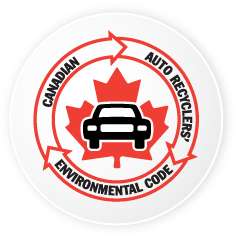
 |
||||||
|
Find out more about the Code & how it can work for your business
Automotive Recycling & The Environment
|
Français | |||||
|
|
||||||
| Automotive Recycling and the Environment
About 83% of an average car's content by weight can be recycled. That is one reason why it is important to ensure that your end-of-life vehicle (ELV) ends up in the hands of a responsible automotive recycler or dismantler. Vehicles also contain hazardous materials such as mercury, lead, refrigerants, antifreeze, oils and gasoline and other fluids which must be carefully removed and responsibly managed. Choosing a responsible recycler means these materials do not end up polluting our environment. The Canadian Auto Recyclers Environmental Code (CAREC) was developed to help standardize the process for recycling ELV’s and protect our water, air and soil from the harmful materials contained therein. The Code was developed by The Automotive Recyclers of Canada (ARC) for the Retire Your Ride program to provide participating recyclers with the most relevant and up-to-date tools and information for the environmentally sound management of ELVs. Although Retire Your Ride ended on March 31, 2011, the Code is here to stay. |
|
||||||||||||||||||||||||||||||||||
| In today’s auto recycling industry , each vehicle commonly goes through a methodical process designed to maximize the amount of material that can be reclaimed and minimize the environmental impact, when proper environmental management is followed. The recycling process happens in three stages: | ||||||||||||||
| Pre-treatment: drainage of operating fluids | Parts Re-use: dismantling of parts and components |
Recycling of materials | ||||||||||||
| Oil, gas and operating fluids pose a significant risk to the environment. Trained technicians carefully drain all the fluids and store them for re-use or recycling. Special equipment and methods are used in order to prevent any groundwater contamination. An average of 40 litres of fluids are removed from each vehicle and are used, re-used or responsibly disposed of.
Take a look at what happens to each of the parts and substances below: |
||
|
|
|||||||||||||||||||||||
| The vehicle is sent to the auto recycler’s dismantling area, where parts are removed, inspected and readied for resale. Each part is tagged, coded and entered into a computerized inventory system before it is properly stored.
Gas tanks, batteries and tires are also removed and recycled, re-used or disposed of appropriately.
Each vehicle is inspected to determine which parts are appropriate for re-use. The vehicle identification number (VIN), mileage, make, model and year of the vehicle are recorded in order to provide accurate inventory data.
Take a look at what happens to each of the materials below: |
||
| Lead-AcidBatteries After testing, batteries that are in good condition are sold to customers for re-use. Others are sent to a licensed recycling facility to be rebuilt or recycled. |
Tires Quality tires with lots of tread life are sold for re-use. Others are sent to tire recyclers and processed as tire crumb to make new products or to pave our highways. |
Wheels Wheels are sold for re-use. In some cases, they are reconditioned. Damaged wheels are reclaimed as scrap metal.. |
||||||||||||
| The remaining portion of the vehicle is then crushed and sent to be shredded into fist-sized pieces for recovery. Any valuable metals – approximately 75% of the vehicle - are separated and re-used to make new cars and other consumer products... and the cycle starts again. | ||
|
 |
||||
| © Copyright 2012 Automotive Recyclers of Canada | |||||